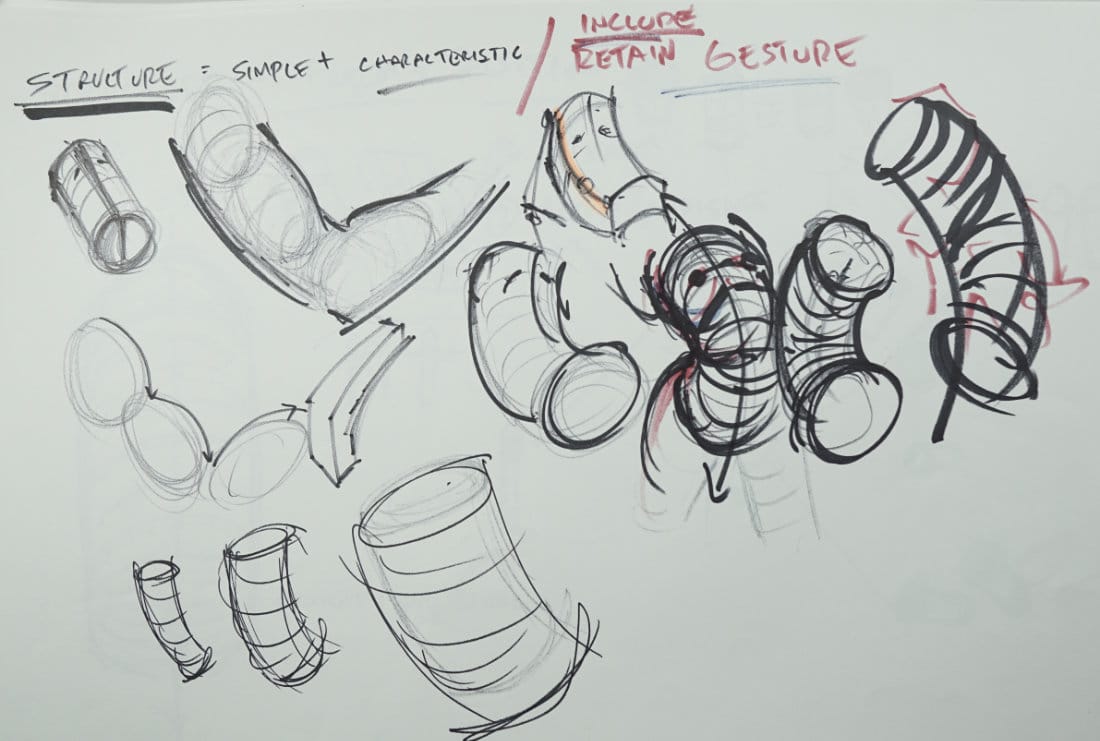Simple & Characteristic: Why Tubes Beat Boxes for Figure Drawing
Structure should be simple. But it also needs to be characteristic. Here's why the tube is your secret weapon for figure drawing - and why boxes can actually make things harder than they need to be.

Structure should be simple, especially for figure drawing. But it also needs to be characteristic.
Here's why the tube is your secret weapon - and why boxes can actually make things harder.
This lesson is part of the Figure Drawing Course - a complete free course teaching you to draw the human body from scratch.
Watch the full lesson - hit play and discover the simple yet characteristic methods for figure drawing.
The Tube: Your Go-To Form
A straight tube is structural - it has corners, an axis, and sides. But you can make it gestural by curving it.
Why tubes work:
- Give you an axis quickly
- Show multiple sides at once
- Allow "over the form" construction lines
- Encompass multiple muscles in one gesture
Example: The arm
Instead of drawing separate eggs for the deltoid, bicep, and forearm muscles, use TWO tubes:
- Upper arm (shoulder to elbow)
- Forearm (elbow to wrist)
Then ADD the individual muscles within that flowing structure. You get the gesture down fast, THEN refine.

Tubes vs Boxes: The Corner Problem
Boxes give you three corners (great information), but they create a challenge: finding that interior corner.
When a figure is lying down and you're looking at the torso, where exactly does that center edge of the box fall? It's hard to locate.
Tubes solve this:
- No interior corner to hunt for
- Find the length, find the width, add construction lines
- Draw the center line, place features (nipples, etc.)
- Modify into corners LATER if needed
Start with the tube, tweak toward a box if necessary. Don't start with the box and fight the corner placement.
Tubes Bend and Flow
This is the magic: tubes are incredibly versatile.
A tube can:
- Bow away from you
- Curl toward you
- Bend in the middle
- Taper at the ends
- Flow in completely different directions top to bottom
The torso bowing back? Tube bends away. Coming forward? Tube curves toward you. The tube handles complexity naturally.
Boxes? Stiffer. Harder to show that organic bend.
Retain Gesture Through Structure
Here's the trap: you lay in a beautiful flowing tube, then add details, and suddenly it looks stiff and robotic.
Don't lose the gesture when rendering.
Those jagged marks, those sharp details - they kill the flow. Keep things organic even as you add muscle groups, features, and refinement.
The tube HELPS you retain gesture because it's already curved and flowing.
Characteristic Forms
Every subject has character. Match your forms to that character.
Heroic muscular figure?
- Thick tubes
- Strong, girthy limbs
- Emphasize mass and strength
Lean, thin figure?
- Narrow tubes
- Delicate proportions
- Emphasize elegance
The form should represent the character of your subject from the start.
The Process
1. Lay in with tubes (quick, gestural, flowing)
2. Add construction lines (over the form, not around)
3. Place major landmarks (center line, features, joints)
4. Refine with characteristic shapes (individual muscles, volumes)
5. Keep the gesture alive (don't get stiff with details)
Simple forms. Characteristic shapes. Retained gesture.
That's the formula.
Course Navigation
Part of: Figure Drawing Course > Module 1: Foundation
← Previous Lesson: Forms With Perspective
Next Lesson → Pencil Methods
Continue Learning
If you enjoyed this hand drawing course, explore even more lessons on our Free Drawing Tutorials & Courses Hub — including the complete How to Draw – Beginner’s Course.
Want new tutorials delivered to your inbox? Subscribe here and get free lessons, tips, and inspiration sent directly to you.




